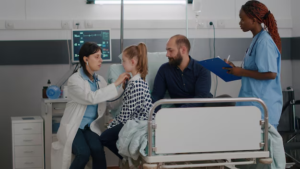The Evolution of APP Education and Training: Trends and Future Directions
Advanced Practice Providers (APPs) such as Nurse Practitioners (NPs), Physician Assistants (PAs), and Certified Nurse Midwives (CNMs) are most likely the most powerful professionals of the modern medical era. APPs’ education and preparedness have transformed completely over the decades in line with the growing demands of an increasingly intricate healthcare system. From graduate-level specialty residencies and clinical programs to continuing education mandates and technology implementation, the world of APP education is evolving at a dizzying pace. This article addresses trends in the future of APP education, current challenges, and direction for the future in training programs for keeping APPs at the forefront of providing patient care.
Historical Overview of APP Education
APP educational development was prompted primarily by doctor shortages and a need for cheap, high-quality provision of health care.
Role of the Nurse Practitioner (NP) (1965)
The University of Colorado initiated the first NP program as a result of primary care needs. It emphasized clinical skill, patient diagnosis, and patient management and further developed the nurses’ role in direct patient care.
The PA Profession (1967)
Duke University introduced the first PA program to educate back-from-training medics. This brief model of medical education focused on generalist training and flexibility.
Certified Nurse Midwives (CNMs)
Midwife education increased to university-based programs in the mid-20th century, integrating evidence-based obstetric practice into professional training.
With APP education on the way, educational programs transitioned from certificate and associate degree programs to graduate degrees with specialism focus, inter-professional practice, and clinical practice.
Current Trends of APPs’ Education
Nurse Practitioner (NP) Education
To practice as an NP, one requires:
- A Bachelor of Science in Nursing (BSN) and a Registered Nurse (RN) license.
- A Master of Science in Nursing (MSN) or Doctor of Nursing Practice (DNP).
For specialty practice like pediatrics, cardiology, psychiatry, or primary practice, DNP degrees are required in most states today, enabling increased academic preparation for NPs.
Physician Assistant (PA) Education
PA education uses a medical-model curriculum and the following conditions:
- A bachelor’s degree and sciences prerequisites.
- A 2-3 year Master’s-level PA program with general clinical rotations in family practice, emergency practice, surgery, etc.
- Successful completion of the Physician Assistant National Certifying Exam (PANCE) for licensure.
PAs are educated as generalists, unlike NPs, and can change specialties without specialty certification, and thus are more career flexible.
Certified Nurse Midwife (CNM) Education
Potential CNMs need to:
- Have a Bachelor of Science in Nursing (BSN).
- Finish a Master’s or Doctoral degree in Nurse-Midwifery from an Accredited Midwifery Program.
- Become nationally certified by the American Midwifery Certification Board (AMCB).
CNM education centers on the full range of maternity care, including pregnancy, labor, postpartum, and reproductive health.
Trends in APP Education and Training
1. The Trend Toward Doctoral-Level Training
Organizations such as the American Association of Nurse Practitioners (AANP) are encouraging doctoral-level education as the entry-point benchmark for NPs. The Doctor of Nursing Practice (DNP) is becoming increasingly the first choice compared to the Master of Science in Nursing (MSN). There are some states that are contemplating the shift of PA education to a doctoral model (Doctor of Medical Science – DMSc), but most states are predominantly at the master’s level. The shift will further enhance leadership, evidence-based practice, and ready APPs for more complex healthcare environments.
2. Additional Clinical Residency and Fellowship Programs
Although APP education does involve clinical rotations, there is greater necessity for formal post-graduate residencies. NP residencies and fellowships in oncology, acute care, and emergency medicine are more common. PA post-graduate training in surgical subspecialty, cardiology, and critical care is increasing, especially in hospitals. CNM mentorship programs are being created to support a transition to independent practice midwifery. Residencies provide continuity from the classroom to actual patient care, better preparing APPs for high-stakes practice.
3. Focus on Interprofessional Education (IPE)
Care is increasingly becoming a teamwork, and APPs must work alongside physicians, nurses, pharmacists, and other health care workers. Interprofessional education (IPE) involves teaching APPs and medical students in the same classes to learn together to increase team communication, patient safety, and decision-making. PA programs are more widely embracing collaborative educational models in medical school. Simulation-based learning adds to IPE by simulating real clinical situations in training. The model builds interprofessional cooperation and results in improved patient outcomes.
4. APP Education Role for Technology
Emerging technologies are transforming APP education:
- Augmented and virtual reality complement virtual clinical experience, expanding procedure and diagnosis skills.
- Telemedicine instruction is an academic component of APPs now that enables practitioners to efficiently treat patients in remote locations.
- Artificial intelligence (AI) is powering medical decision-making, diagnosis, and patient teaching, calling for convergence toward AI-seamless healthcare.
These developments improve access to training plans and clinical skill development, particularly to rural or disadvantaged regions.
APP Training Issues
Despite giant leaps in Advanced Practice Provider (APP) education, several obstacles are present and have an effect on the quality, availability, and uniformity of training programs. These affect not only APP students and instructors but also whether or not numerous qualified providers are ready to enter the workforce.
1. Preceptor Shortage in Clinical Training
The most important APP training problem is having a lack of clinical preceptors who are experienced practitioners that supervise students in the real patient care setting. In contrast to medical schools, which have permanent placements in hospitals, most NP and PA programs utilize volunteer preceptors who are part of large health systems.
Whereas the majority of willing preceptors are discouraged by high patient volumes, low compensation, and lack of adequate time, the majority of others refuse to get involved or limit involvement in clinical education. Such deficiencies lead to program delay, with some students delaying graduation or being placed in suboptimal clinical placements outside their desired specialties. Preceptor course development, financial incentives, and educational credit would encourage more health care personnel in training roles.
2. State and Institutional Restraints
A second significant barrier to effective APP training is variability of state practice laws and institutional policy. Because scope of practice in APP is radically different between states, ranging from full practice authority to extremely restrictive models, education programs must navigate difficult legal environments while curating curriculum. For example, with restrictive practice statute laws, PAs and NPs must practice under the supervision of physicians, thus limiting exercising independent clinical judgment skills. Health and hospital policy also has a disadvantage, which includes deciding training and exposure opportunities for students in the clinics. Standardization of APP practice guidelines across all the states would foster consistency of education and mobility of workforce in a way that training courses can prepare graduates in due proportion for solo practice as approved.
Future APP Education and Training Plans
Future APP education plans over the next several years will include:
- National Standardization of Scope of Practice: One bill and one license per state, which will allow APPs more mobility.
- Increased Specialist Training Tracks: Neurology, orthopedic, dermatology, and critical care APP training will need specialist fellowships.
- Expanded Integration of AI and Digital Health Platforms: APP programs will include machine learning, big data, and digital health platforms in their course work.
- Increased Application of Hybrid Models of Learning: Increased application of face-to-face and virtual learning to provide greater accessibility and flexibility in education.
- Increased Federal and Institutional Funding through Support for Training: Government programs can finance financial aid to APP residency programs to provide more clinical readiness.
Since medical needs are always in a state of change, education and training for APPs must also adjust to provide the professional with the required skill to address today’s problems of health concerns.
Conclusion
APP education and training have come a long way from the earliest stage certificate degrees to advanced-level doctoral degrees. Increased length of residencies, interprofessional education, and technology-driven training are developing the next breed of APPs.
Although there remain issues to be addressed, continued policy, curriculum, and methodology development will continue to advance the competence, autonomy, and influence of APPs in health care. As demand for APPs increases, well-designed effective education and training must be maintained to address future health care needs.
Check out these other great Staffdna articles

Hospitalist Jobs vs. General Physician Assistant Jobs: What’s the Difference?
When medical professionals are considering their career options, the first things that come to mind are either hospitalists or general physician assistants.

Busting Myths About PRN Nursing Jobs: Pros, Cons & How to Find the Best Shifts
PRN nursing jobs have become a favorite among medical professionals looking for flexibility and higher pay. Yet, many misconceptions exist about PRN positions that scare some nurses away from considering it as a career choice.

How to Handle the Pressure of PACU Nursing Jobs Without Burning Out
Nursing is a demanding field, which becomes even more challenging when it comes to PACU nursing jobs.

How to Transition from Staff Nurse to A Travel Nurse
If you are a Registered Nurse with a strong desire to travel to different locations and save lives, you can be a travel nurse.

Travel Nursing: How to Choose the Best Career Assignments
Travel nursing is one way for nurses to work through new locations while also building their skill sets.

Understanding the PICU: A Guide for PICU Nurses
The pediatric intensive care unit (PICU) is a specialized department in hospitals and medical facilities. It is made to provide intensive care to infants, children, and adolescents with severe medical conditions.
